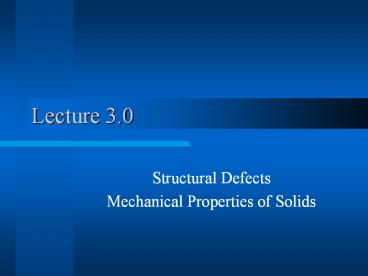Structural Defects PowerPoint PPT Presentation
Title: Structural Defects
1
Lecture 3.0
- Structural Defects
- Mechanical Properties of Solids
2
Defects in Crystal Structure
- Vacancy, Interstitial, Impurity
- Schottky Defect
- Frenkel Defect
- Dislocations edge dislocation, line, screw
- Grain Boundary
3
Substitutional Impurities Interstitial Impurities
4
Self Interstitial Vacancy
Xv exp(-?Hv/kBT)
5
Vacancy Equilibrium
Xv exp(-?Hv/kBT)
6
Defect Equilibrium
Sc kBln gc(E) Sb kBln Wb
Entropy Ss kBln Ws
dFc dE-TdSc-TdSs, the change in free
energy dFc 6 nearest neighbour bond energies
(since break on average 1/2 the bonds in the
surface) Wb(Nn)!/(N!n!) (Nn1)/(n1)
(Nn)/n (If one vacancy added) dSbkBln((Nn)/n)
For large crystals dSsltltdSb \ \n N exp
dFc/kBT
7
Ionic Crystals
Shottky Defect Frenkel Defect
8
Edge Dislocation
9
Grain Boundaries
10
Mechanical Properties of Solids
- Elastic deformation
- reversible
- Youngs Modulus
- Shear Modulus
- Bulk Modulus
- Plastic Deformation
- irreversible
- change in shape of grains
- Rupture/Fracture
11
Modulii
Shear
Youngs
Bulk
12
Mechanical Properties
- Stress, ?xx Fxx/A
- Shear Stress, ?xy Fxy/A
- Compression
- Yield Stress
- ?yield Y/10
- ?yieldG/6 (theory-all atoms to move together)
- Strain, ??x/xo
- Shear Strain, ??y/xo
- Volume Strain ?V/Vo
- Brittle Fracture
- stress leads to crack
- stress concentration at crack tip 2?(l/r)
- Vcrack Vsound
13
Effect of Structure on Mechanical Properties
- Elasticity
- Plastic Deformation
- Fracture
14
Elastic Deformation
- Youngs Modulus
- Y(or E) (F/A)/(?l/lo)
- Shear Modulus
- G?/? Y/(2(1?))
- Bulk Modulus
- K-P/(?V/Vo)
- KY/(3(1-2?))
- Pulling on a wire decreases its diameter
- ?l/lo -??l/Ro
- Poissons Ratio, ??0.5 (liquid case0.5)
15
Microscopic Elastic Deformation
- Interatomic Forces
- FT Tensile Force
- FCCompressive Force
- Note F-d(Energy)/dr
16
Plastic Deformation
?
?
- Single Crystal
- by slip on slip planes
Shear Stress
17
Deformation of Whiskers
Without Defects Rupture
With Defects generated by high stress
18
Dislocation Motion due to Shear
19
Slip Systems in Metals
20
Plastic Deformation
Ao
- Poly Crystals
- by grain boundaries
- by slip on slip planes
- Engineering Stress, Ao
- True Stress, Ai
Ai
21
Movement at Edge Dislocation
Slip Plane is the plane on which the dislocation
glides Slip plane is defined by BV and I
22
Plastic Deformation -Polycrystalline sample
- Many slip planes
- large amount of slip (elongation)
- Strain hardening
- Increased difficulty of dislocation motion due to
dislocation density - Shear Stress to Maintain plastic flow, ? ?oGb??
- dislocation density, ?
Strain Hardening
23
Strain Hardening/Work Hardening
- Dislocation Movement forms dislocation loops
- New dislocations created by dislocation movement
- Critical shear stress that will activate a
dislocation source - ?c2Gb/l
- GShear Modulus
- bBurgers Vector
- llength of dislocation segment
24
Depends on Grain Size
25
Burgers Vector-Dislocations are characterised
by their Burger's vectors. These represent the
'failure closure' in a Burger's circuit in
imperfect (top) and perfect (bottom) crystal.
BV Perpendicular to Dislocation
BV parallel to Dislocation
26
Solution Hardening (Alloying)
- Solid Solutions
- Solute atoms segregate to dislocations reduces
dislocation mobility - higher ? required to move dislocation
- Solute Properties
- larger cation sizelarge lattice strain
- large effective elastic modulus, Y
- Multi-phase alloys - Volume fraction rule
27
Precipitation Hardening
- Fine dispersion of heterogeneity
- impede dislocation motion
- ?c2Gb/?
- ? is the distance between particles
- Particle Properties
- very small and well dispersed
- Hard particles/ soft metal matrix
- Methods to Produce
- Oxidation of a metal
- Add Fibers - Fiber Composites
28
Cracking vs Plastic Deformation
- Brittle
- Poor dislocation motion
- stress needed to initiate a crack is low
- Ionic Solids
- disrupt charges
- Covalent Solids
- disrupt bonds
- Amorphous solids
- no dislocations
- Ductile
- good dislocation motion
- stress needed to initiate slip is low
- Metals
- electrons free to move
- Depends on T and P
- ductile at high T (and P)

